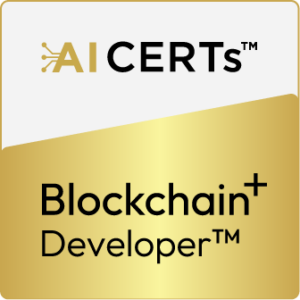- modules: 12
- Examination: 1
- Examination Time: 50 MCQs, 90 Minutes
- Passing Score: 70%
About Certification
The Blockchain+ Developer certification offers a comprehensive journey into blockchain technology and smart contracts. Beginning with the origin and structure of blockchain, participants explore consensus mechanisms and the concept of smart contracts, delving into Ethereum Virtual Machine (EVM) and Solidity basics. Advanced topics cover Solidity structures, tokenization, and non fungible tokens (NFTs). Development tools like Truffle and Ganache are introduced, along with testing techniques and DApp integration. Participants then explore private blockchain with Hyperledger Fabric, learning its architecture, Docker setup, and Golang programming. The course culminates in chaincode development, REST API integration, and chain code auditing.
Prerequisites
- Familiarity with general programming concepts like data structures, algorithms and networks
- Understanding of at least one legacy programming stack (e.g. Python, JavaScript, Java or similar)
- Fundamental knowledge to use command line consoles on any operating system
- Ability to understand developer concepts like SDKs, APIs, application development tools etc.
- Experience with building end to end tiered applications
Certification Modules
- 1.1 Origin of Blockchain
- 1.2 What is Blockchain?
- 1.3 Consensus Mechanisms
- 1.4 What are Smart Contracts?
- 1.5 Bitcoin Blockchains
- 2.1 What is an EVM and Ethereum?
- 2.2 Wallets Introduction and Creation
- 2.3 Introduction to Remix Editor with Metamask
- 2.4 Smart Contract Basic Structure
- 2.5 Variables, If/Else, Strings, Loops, Arrays, Test Tokens
- 3.1 Libraries, Interfaces, Modifiers
- 3.2 Structures, Enums, ABI, Calldata, Events, and Transfers
- 3.3 Contract-to-Contract Calls
- 3.4 Address and Address Payable
- 3.5 Receive and Fallback Functions
- 3.6 Upgradeable Contracts
- 3.7 Openzepplin Libraries
- 4.1 ERC20 Token Creation
- 4.2 NFT, NFT Minting, IPFS, Security, and Pinata Cloud
- 5.1 Truffle, Ganache, and Hardhat
- 5.2 Metamask Wallet
- 5.3 Remix Development Environment
- 5.4 Localnet and Testnet Deployment
- 6.1 Web3.0 Integration with JS
- 6.2 Wallet Creation and Sending Transactions
- 7.1 Public Vs Private vs. Consortium Blockchain Frameworks
- 7.2 Introduction to the Hyperledger Fabric
- 7.3 Hyperledger Projects
- 8.1 Basic Concepts of HLF
- 8.2 Docker Introduction
- 8.3 Commands and Setup
- 9.1 Installation and Path Setup
- 9.2 VS Code Plugin Setup, Variables, Strings, Conditional Statements, and Loops
- 9.3 Basics of the Language
- 10.1 Chain code Explanation using Fabric Samples and Test-network Explanation using Linux Scripting
- 10.2 Error Handling
- 10.3 Error Codes and Messages
- 10.4 Logging Errors
- 10.5 Handling Panics
- 11.1 Extending the Default Chaincode
- 11.2 Chaincode Deployment
- 11.3 REST API Integration with Front End
- 12.1 Why Smart Contract Audits are Necessary
- 12.2 Introduction to Firefly, Fabconnect, and Blockchain Explorer
Certification outcome
Upon completion of this course, participants will gain a comprehensive understanding of blockchain and smart contracts. They'll delve into the origin and mechanics of blockchain, explore consensus mechanisms, and grasp the concept of smart contracts. Additionally, they'll master Ethereum Virtual Machine (EVM) and Solidity basics, learning to create wallets, deploy smart contracts, and work with advanced Solidity features. The curriculum covers tokenization, NFTs, development tools like Truffle and Docker, DApp integration, and a deep dive into Hyperledger Fabric, including Golang programming for Chaincode development. Participants will also learn chaincode development, error handling, and chaincode auditing, ensuring a robust understanding of blockchain technology.











